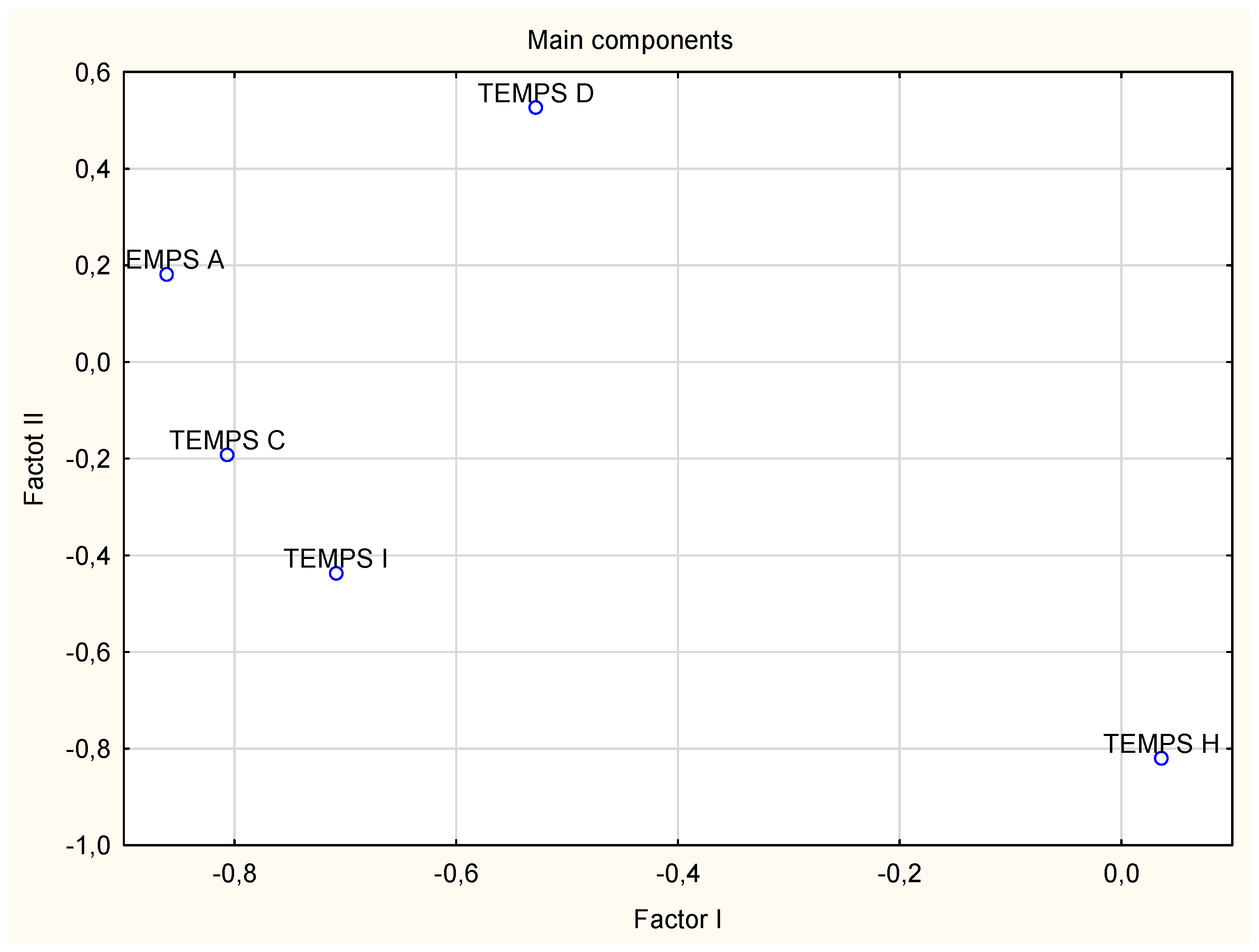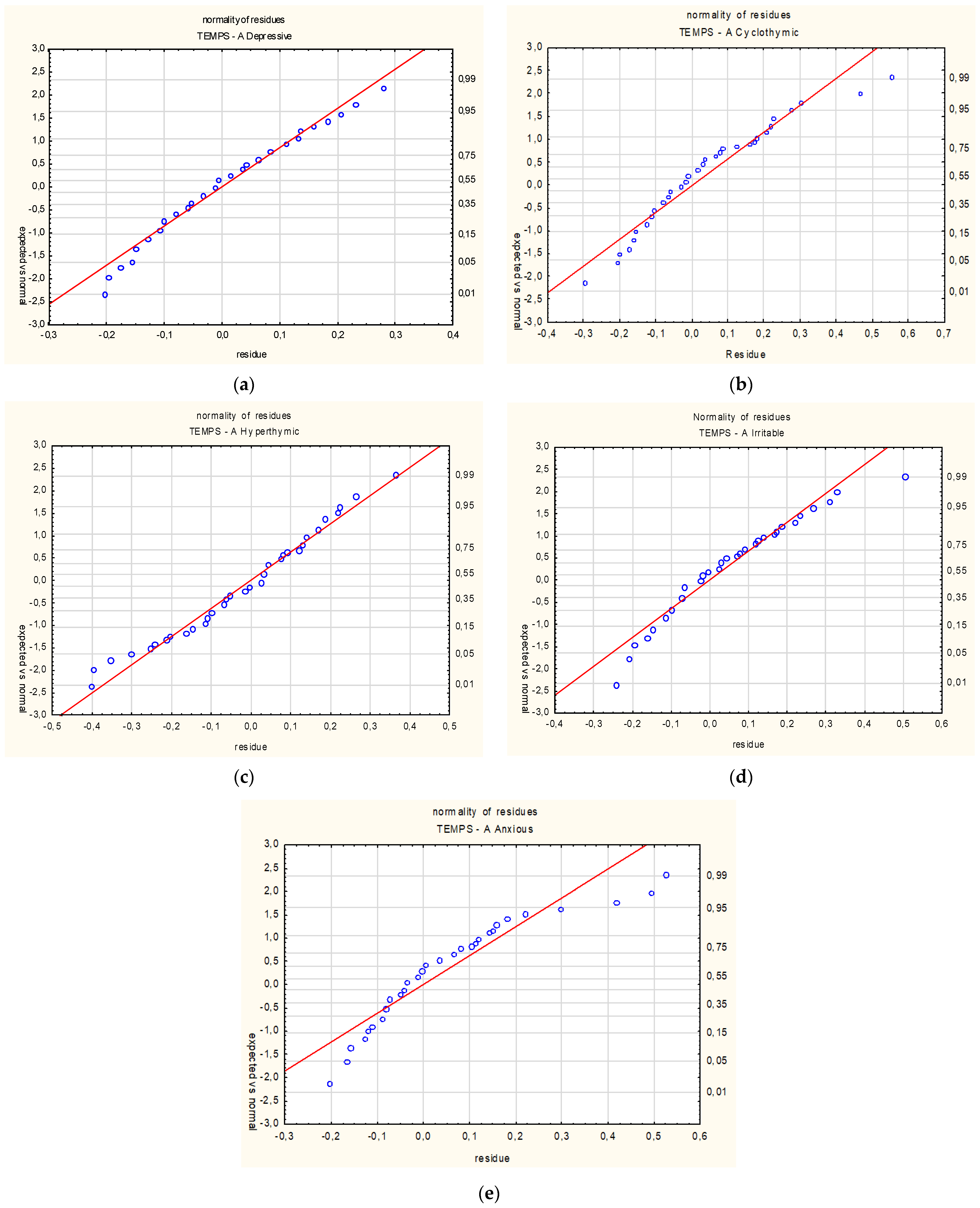A Feasibility Study of the Usefulness of the TEMPS-A Scale in Assessing Affective Temperament in Athletes
Abstract
:1. Introduction
2. Materials and Methods
2.1. Subjects
2.2. Methods
2.3. Statistical Analysis
3. Results
3.1. Internal Consistency of TEMPS-A
3.2. The Affective Temperament Profile
4. Discussion
5. Conclusions
Author Contributions
Funding
Institutional Review Board Statement
Informed Consent Statement
Data Availability Statement
Conflicts of Interest
References
- Peluso, M.A.; Guerra de Andrade, L.H. Physical activity and mental health: The association between exercise and mood. Clinics 2005, 60, 61–70. [Google Scholar] [CrossRef] [Green Version]
- Wiles, N.J.; Haase, A.M.; Gallacher, J.; Lawlor, D.A.; Lewis, G. Physical Activity and Common Mental Disorder: Results from the Caerphilly Study. Am. J. Epidemiol. 2007, 165, 946–954. [Google Scholar] [CrossRef]
- Janssen, J.A.; Kolacz, J.; Shanahan, L.; Gangel, M.J.; Calkins, S.D.; Keane, S.P.; Wideman, L. Childhood temperament predictors of adolescent physical activity. BMC Public Health 2017, 17, 8. [Google Scholar] [CrossRef] [PubMed] [Green Version]
- Rhodes, R.E.; Janssen, I.; Bredin, S.S.D.; Warburton, D.E.R.; Bauman, A. Physical activity: Health impact, prevalence, correlates and interventions. Psychol. Health 2017, 32, 942–975. [Google Scholar] [CrossRef] [PubMed]
- Korczak, D.J.; Madigan, S.; Colasanto, M.; Szatmari, P.; Chen, Y.; Maguire, J.; Parkin, P.; Birken, C.S. The longitudinal association between temperament and physical activity in young children. Prev. Med. 2018, 111, 342–347. [Google Scholar] [CrossRef] [PubMed]
- Han, D.H.; Kim, J.H.; Lee, Y.S.; Bae, S.J.; Bae, S.J.; Kim, H.J.; Sim, M.Y.; Sung, Y.H.; Lyoo, I.K. Influence of temperament and anxiety on athletic performance. J. Sports Sci. Med. 2006, 5, 381–389. [Google Scholar]
- Mehrabian, A.; Bekken, M.L. Temperament Characteristics of Individuals Who Participate in Strenuous Sports. Res. Q. Exerc. Sport 1986, 57, 160–166. [Google Scholar] [CrossRef]
- Akiskal, K.K.; Akiskal, H.S. The theoretical underpinnings of affective temperaments: Implications for evolutionary foundations of bipolar disorder and human nature. J. Affect. Disord. 2005, 85, 231–239. [Google Scholar] [CrossRef]
- Akiskal, H.S.; Akiskal, K.K. Special issue: TEMPS: Temperament evaluation of Memphis, Pisa, Paris and San Diego. J. Affect. Disord. 2005, 85, 1–242. [Google Scholar] [CrossRef]
- Leźnicka, K.; Starkowska, A.; Tomczak, M.; Cięszczyk, P.; Białecka, M.; Ligocka, M.; Żmijewski, P.; Pawlak, M. Temperament as a modulating factor of pain sensitivity in combat sport athletes. Physiol. Behav. 2017, 180, 131–136. [Google Scholar] [CrossRef]
- Sulis, W. Assessing the continuum between temperament and affective illness: Psychiatric and mathematical perspectives. Philos. Trans. R. Soc. B Biol. Sci. 2018, 373, 20170168. [Google Scholar] [CrossRef] [PubMed] [Green Version]
- Białczyk, K.; Wyszkowska, Z.; Bieliński, M. Affective Temperament is Associated with Stress Coping Strategies and Work Stress Perception Among Polish Bank Employees. Psychol. Res. Behav. Manag. 2020, 13, 1333–1342. [Google Scholar] [CrossRef] [PubMed]
- Azorin, J.; Adida, M.; Belzeaux, R. Predominant polarity in bipolar disorders: Further evidence for the role of affective temperaments. J. Affect. Disord. 2015, 182, 57–63. [Google Scholar] [CrossRef] [PubMed]
- Baldessarini, R.J.; Innamorati, M.; Erbuto, D.; Serafini, G.; Fiorillo, A.; Amore, M.; Girardi, P.; Pompili, M. Differential associations of affective temperaments and diagnosis of major affective disorders with suicidal behavior. J. Affect. Disord. 2017, 210, 19–21. [Google Scholar] [CrossRef]
- Jaracz, M.; Bialczyk, K.; Ochocinski, A.; Szwed, M.; Jaracz, K.; Borkowska, A. Contributions of Affective Temperament Traits to Professional Choice: Evidence from the Study of Firefighters, Musicians, Athletes, Bank Managers, Nurses and Paramedics. Psychol. Res. Behav. Manag. 2021, 14, 827–834. [Google Scholar] [CrossRef]
- Borkowska, A.; Rybakowski, J.K.; Drozdz, W.; Bielinski, M.; Kosmowska, M.; Rajewska-Rager, A.; Bucinski, A.; Akiskal, K.K.; Akiskal, H.S. Polish validation of the TEMPS-A: The profile of affective temperaments in a college student population. J. Affect. Disord. 2010, 123, 36–41. [Google Scholar] [CrossRef]
- Gee, C.J. How does sport psychology actually improve athletic performance? A framework to facilitate athletes’ and coaches’ understanding. Behav. Modif. 2010, 34, 386–402. [Google Scholar] [CrossRef]
- Müller, A.; Claes, L.; Wos, K.; Kerling, A.; Wünsch-Leiteritz, W.; Cook, B.; De Zwaan, M. Temperament and Risk for Exercise Dependence: Results of a Pilot Study in Female Patients with Eating Disorders Compared to Elite Athletes. Psychopathology 2015, 48, 264–269. [Google Scholar] [CrossRef]
- Egan, K.P. Supporting Mental Health and Well-being among Student-Athletes. Clin. Sports Med. 2019, 38, 537–544. [Google Scholar] [CrossRef]
- Fico, G.; Caivano, V.; Zinno, F.; Carfagno, M.; Steardo, L.; Sampogna, G.; Luciano, M.; Fiorillo, A. Affective Temperaments and Clinical Course of Bipolar Disorder: An Exploratory Study of Differences among Patients with and without a History of Violent Suicide Attempts. Medicina 2019, 55, 390. [Google Scholar] [CrossRef] [Green Version]
- Lara, D.R.; Bisol, L.W.; Brunstein, M.G.; Reppold, C.T.; de Carvalho, H.W.; Ottoni, G.L. The Affective and Emotional Composite Temperament (AFECT) model and scale: A system-based integrative approach. J. Affect. Disord. 2012, 140, 14–37. [Google Scholar] [CrossRef] [PubMed]
- Vázquez, G.H.; Tondo, L.; Mazzarini, L.; Gonda, X. Affective temperaments in general population: A review and combined analysis from national studies. J. Affect. Disord. 2012, 139, 18–22. [Google Scholar] [CrossRef] [PubMed]
- Dudek, D.; Siwek, M.; Jaeschke, R.; Drozdowicz, K.; Styczeń, K.; Arciszewska, A.; Chrobak, A.A.; Rybakowski, J.K. A web-based study of bipolarity and impulsivity in athletes engaging in extreme and high-risk sports. Acta Neuropsychiatr. 2016, 28, 179–183. [Google Scholar] [CrossRef] [PubMed]
- Gustafsson, H.; Sagar, S.S.; Stenling, A. Fear of failure, psychological stress, and burnout among adolescent athletes competing in high level sport. Scand. J. Med. Sci. Sports 2016, 27, 2091–2102. [Google Scholar] [CrossRef]
- Maremmani, I.; Dell’Osso, L.; Rovai, L.; Pacini, M.; Arduino, G.; Montagnari, A.; Abbenante, D.; Maremmani, A.G.; Giulio, P.; Akiskal, K.; et al. TEMPS-A[p] temperament profile related to professional choice: A study in 1548 applicants to become a cadet officer in the Italian air force. J. Affect. Disord. 2010, 124, 314–318. [Google Scholar] [CrossRef]
- Maremmani, I.; Maremmani, A.G.I.; Leonardi, A.; Rovai, L.; Bacciardi, S.; Rugani, F.; Dell’Osso, L.; Akiskal, K.; Akiskal, S.H. Temperamental traits and results of psychoaptitude tests in applicants to become a cadet officer in the Italian Navy. J. Affect. Disord. 2013, 150, 634–638. [Google Scholar] [CrossRef]
- Yuan, J.; Tian, Y.; Huang, X.; Fan, H.; Wei, X. Emotional bias varies with stimulus type, arousal and task setting: Meta-analytic evidences. Neurosci. Biobehav. Rev. 2019, 107, 461–472. [Google Scholar] [CrossRef]
- Maremmani, I.; Dell’Osso, L.; Rovai, L.; Arduino, G.; Montagnari, A.; Abbenante, D.; Popovic, D.; Maremmani, A.G.; Perugi, G.; Akiskal, K.; et al. Discriminant and convergent validity of TEMPS-A[P] correlation with MMPI and the emotional-affective state following a stressful situation. J. Affect. Disord. 2011, 129, 27–33. [Google Scholar] [CrossRef]
- Jaracz, M.; Rosiak, I.; Bertrand-Bucińska, A.; Jaskulski, M.; Nieżurawska, J.; Borkowska, A. Affective temperament, job stress and professional burnout in nurses and civil servants. PLoS ONE 2017, 12, e0176698. [Google Scholar] [CrossRef] [Green Version]
- Kikuchi, Y.; Nakaya, M.; Ikeda, M.; Okuzumi, S.; Takeda, M.; Nishi, M. Relationship between job stress, temperament and depressive symptoms in female nurses. Int. J. Occup. Med. Environ. Health 2014, 27, 426–434. [Google Scholar] [CrossRef] [Green Version]
- Arnold, R.; Fletcher, D.; Daniels, K. Organisational stressors, coping, and outcomes in competitive sport. J. Sports Sci. 2017, 35, 694–703. [Google Scholar] [CrossRef] [PubMed] [Green Version]
- Firth, J.; Solmi, M.; Wootton, R.E.; Vancampfort, D.; Schuch, F.B.; Hoare, E.; Gilbody, S.; Torous, J.; Teasdale, S.B.; Jackson, S.E.; et al. A meta-review of “lifestyle psychiatry”: The role of exercise, smoking, diet and sleep in the prevention and treatment of mental disorders. World Psychiatry 2020, 19, 360–380. [Google Scholar] [CrossRef] [PubMed]


| Depressive | Cyclothymic | Hyperthymic | Irritable | Anxious | |
|---|---|---|---|---|---|
| Depressive | 1.00 | 0.21 | −0.09 | 0.10 | 0.49 * |
| Cyclothymic | 1.00 | −0.02 | 0.54 * | 0.47 * | |
| Hyperthymic | 1.00 | 0.15 | −0.18 | ||
| Irritable | 1.00 | 0.44 * |
| Factor | ||
|---|---|---|
| I | II | |
| Depressive | 0.53 | 0.53 |
| Cyclothymic | 0.81 * | 0.19 |
| Hyperthymic | 0.04 | 0.82 * |
| Irritable | 0.71 * | 0.44 |
| Anxious | 0.86 * | 0.18 |
| Whole Group N = 71 | Females N = 33 | Males N = 38 | Differences between Males and Females p= | |
|---|---|---|---|---|
| Depressive | 0.22 ± 0.11 | 0.19 ± 0.10 | 0.25 ± 0.12 | 0.08 |
| Cyclothymic | 0.23 ± 0.17 | 0.24 ± 0.16 | 0.21 ± 0.18 | 0.20 |
| Hyperthymic | 0.63 ± 0.15 | 0.67 ± 0.16 | 0.60 ± 0.15 | 0.04 |
| Irritable | 0.19 ± 0.15 | 0.24 ± 0.17 | 0.16 ± 0.13 | 0.04 |
| Anxious | 0.16 ± 0.15 | 0.14 ± 0.14 | 0.18 ± 0.15 | 0.24 |
| Groups of Athletes | Differences between Three Groups p Value | Differences between Groups, Mann–Whitney U Test p Value | |||||
|---|---|---|---|---|---|---|---|
| Group I Canoeists | Group II Non-Professional Athletes | Group III Pilots | ANOVA Kruskal Wallis | I vs. II | I vs. III | II vs. III | |
| Depressive | 0.20 ± 0.10 | 0.24 ± 0.14 | 0.22 ± 0.10 | 0.74 | 0.52 | 0.74 | 0.78 |
| Cyclothymic | 0.30 ± 0.18 | 0.21 ± 0.17 | 0.17 ± 0.13 | 0.01 | 0.05 | 0.01 | 0.53 |
| Hyperthymic | 0.63 ± 0.16 | 0.64 ± 0.18 | 0.62 ± 0.11 | 0.58 | 0.91 | 0.58 | 0.57 |
| Irritable | 0.24 ± 0.16 | 0.21 ± 0.17 | 0.12 ± 0.10 | 0.01 | 0.48 | 0.01 | 0.03 |
| Anxious | 0.16 ± 0.16 | 0.20 ± 0.18 | 0.11 ± 0.09 | 0.29 | 0.34 | 0.29 | 0.05 |
| Multidimensional Significance Tests. Parameterization with Sigma Constraints. Decomposition of Active Hypotheses | ||||||
|---|---|---|---|---|---|---|
| Effect | test | value | F | df effect | df error | p |
| Free value | Wilks | 0.039 | 313.52 | 5 | 64 | 0.0000 |
| Type of athletes training | Wilks | 0.744 | 2.04 | 10 | 128 | 0.0343 |
Publisher’s Note: MDPI stays neutral with regard to jurisdictional claims in published maps and institutional affiliations. |
© 2022 by the authors. Licensee MDPI, Basel, Switzerland. This article is an open access article distributed under the terms and conditions of the Creative Commons Attribution (CC BY) license (https://creativecommons.org/licenses/by/4.0/).
Share and Cite
Białczyk, K.; Kłopocki, J.; Kryś, J.; Jaskulski, M.; Lewandowska, A.; Szafkowski, R.; Ogurkowski, K.; Pheby, D.; Morten, K.; Jaracz, M. A Feasibility Study of the Usefulness of the TEMPS-A Scale in Assessing Affective Temperament in Athletes. Medicina 2022, 58, 195. https://doi.org/10.3390/medicina58020195
Białczyk K, Kłopocki J, Kryś J, Jaskulski M, Lewandowska A, Szafkowski R, Ogurkowski K, Pheby D, Morten K, Jaracz M. A Feasibility Study of the Usefulness of the TEMPS-A Scale in Assessing Affective Temperament in Athletes. Medicina. 2022; 58(2):195. https://doi.org/10.3390/medicina58020195
Chicago/Turabian StyleBiałczyk, Katarzyna, Jan Kłopocki, Jacek Kryś, Maciej Jaskulski, Anna Lewandowska, Robert Szafkowski, Karol Ogurkowski, Derek Pheby, Karl Morten, and Marcin Jaracz. 2022. "A Feasibility Study of the Usefulness of the TEMPS-A Scale in Assessing Affective Temperament in Athletes" Medicina 58, no. 2: 195. https://doi.org/10.3390/medicina58020195
APA StyleBiałczyk, K., Kłopocki, J., Kryś, J., Jaskulski, M., Lewandowska, A., Szafkowski, R., Ogurkowski, K., Pheby, D., Morten, K., & Jaracz, M. (2022). A Feasibility Study of the Usefulness of the TEMPS-A Scale in Assessing Affective Temperament in Athletes. Medicina, 58(2), 195. https://doi.org/10.3390/medicina58020195






